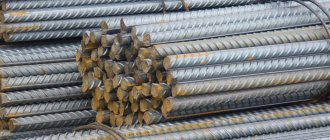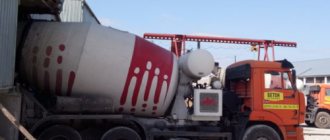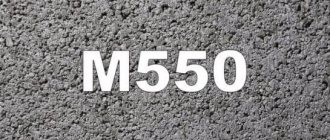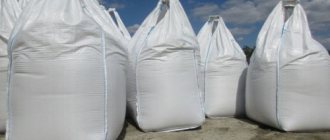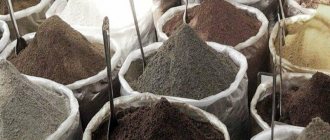Fine concrete is a type of concrete. Its structure completely eliminates the presence of stones or rubble. This material is actively used in the construction of thin walls, roads, hydraulic structures and other areas of construction.
Description of building materials
Fine-grained or sandy concrete is understood as a structural construction raw material based on cement, fine sand and water. The material is included in the category of heavy concrete and is prepared in a similar way, but differs from others in its more uniform structure, less porosity and increased strength. Optimizing the consistency has a positive effect on both the viscosity of the solution and the ease of its installation.
Structure of fine-grained concrete
Due to the absence of large filler particles (more than 2-2.5 mm), the water demand of the cement mixture increases, and this causes an increase in the cement content. To reduce costs, only high-quality sand and reinforced sealant are added to the composition.
Production
To obtain the desired MB composition, the sand is sifted in 3 stages, and then mixed in the proportions given in the table:
| Fraction, mm | Content, % |
| 5—1,25 | 57—63 |
| 1,25—0,315 | 17—23 |
| 0,315—0,14 | 17—23 |
Mixing of dry components is carried out in a ratio of 1:1.5 to 1:3.5, then water is added in an amount determined by the requirement for the plasticity of the mixture. If necessary, the plasticizer is diluted and added. It is important to understand that an increase in the fraction of coarse aggregate will lead to a loss of concrete strength, and an increase in the proportion of fine sand will lead to an increase in the volume of cement used, but also to achieving maximum strength indicators. To improve the quality of the solution, it is compacted by pressing, roller method, vibrocompression or tamping.
Features of fine-grained concrete
The distinctive features of this building material are uniformity and maximum density, which have a positive effect on strength. The latter in a fine-grained mortar is at least 30% greater than that of standard mixtures based on cement and sand. Sand concrete is flexible, therefore it is easily poured into the most inaccessible places, and is also suitable for casting complex shapes. To prevent the penetration of air into the composition, the material is not subjected to vibration, which can reduce its reliability.
Composition and technical characteristics
The specific composition of the solution may change due to different proportions and the introduction of new components, but this statement is only true for home use. In professional construction, the composition of fine-grained concrete is regulated by GOST 26633-91, and it includes three main ingredients:
- cement;
- purified river sand of fraction less than 2.5 mm;
- water.
It is also possible to replace part of the sand with crushed stone of a fraction of less than 5-10 mm and add plasticizers. Among other things, components can be added to the composition to increase strength - crushed slag, ash. As a rule, the amount of cement in fine-grained concrete is 2 times higher than in classic mortar. If the norm is less, then after hardening the cement stone will not gain the required strength. If the volume of cement is exceeded, the concrete will set faster, and this will greatly complicate the work process.
Fine-grained concrete has the following technical characteristics:
- increased bending resistance;
- homogeneous consistency;
- vibration resistance;
- frost resistance;
- moisture resistance;
- optimal porosity.
Basic properties
The main properties of concrete include:
- Strength.
- Water resistance.
- Porosity.
- Frost resistance.
- Thermal conductivity.
- Fire resistance.
Strength
A key indicator of high quality concrete is its strength. Heavy varieties must cope with intense loads, so high demands are placed on strength properties.
They must be observed both at the stage of mixing the mixture and when solving all construction problems. Since concrete is considered a non-uniform material, fluctuations in strength are considered normal.
Water resistance
Concrete is considered a waterproof material that does not lose its initial characteristics after prolonged exposure to a humid environment. Water resistance indicators depend on the ratio of components in the composition and are depicted under the letter W. The value range varies from W2 to W20.
Porosity
Even the most durable brands of concrete have small cells, which determine a property such as porosity. The intensity of porosity is determined by the type and volume of filler, as well as the ratio of water and cement. The degree of vibration treatment and a host of other factors are also taken into account. The base value varies from 6 to 15%.
Frost resistance
The degree of frost resistance indicates the material’s resistance to the destructive effects of negative temperatures or loads when moisture thaws after a long winter. Frost resistance refers to the number of freezing and defrosting cycles. The more such cycles, the higher the indicator. Commercially available brands have values from 50 to 300 cycles.
Thermal conductivity
The weak point of concrete is its thermal conductivity. Despite the improved strength properties and long service life, the material is subject to severe freezing and cannot retain heat inside itself. As density increases, thermal conductivity increases.
Fire resistance
Fire resistance is considered the most important property of a material, which determines its resistance to ignition. When exposed to temperatures up to 200ºС, strength characteristics are reduced by 30%. When the temperature rises to 500ºС, the structure deforms.
Advantages and disadvantages of the material
Fine-grained concrete has many advantages over traditional compositions:
- improved physical and mechanical characteristics - bending and tensile strength, tolerance of high loads and vibration, ductility, good fluidity and penetrating ability;
- the possibility of imparting new properties through the introduction of additives (water resistance, acid resistance, alkali resistance, etc.);
- maximum homogeneous solution structure;
- suitability for a wide variety of construction and repair work, including for pouring products of complex shapes, a wide range of methods for creating concrete structures;
- high frost resistance - 2 times more than traditional concrete;
- ease of transportation, low risk of delamination;
- high density of finished concrete stone.
Fine-grained concrete also has disadvantages. Among them, it is worth noting the hardness after hardening, which complicates the subsequent processing of products and structures. To create a solution, you have to spend an increased amount of cement. As the material gains strength, it shrinks, which must be taken into account before performing work.
Types of architectural concrete
According to the composition of the mixture, properties and method of molding, archstone can be:
- Geometric - for creating conventional monolithic structures in formwork, the work is similar to construction from simple concrete.
- Decorative – for finishing finished structures, using various tools and technologies.
- Sculptural – for creating three-dimensional decorative compositions. It is characterized by increased plasticity, resistance to external influences, and long-term hardening (so that something can be modified in the process). The process of making sculptures is simple: they create a frame, cover it with a mesh, apply concrete to it, and after lightly setting it with tools and hands, create a shape.
According to its intended purpose, the material can be white decorative (for finishing facades and various internal surfaces) and white lightweight (for creating products and elements with low weight). Among modern materials for decoration, there are colored and polished and photoconcrete, translucent and textured with formliners. Complex materials are created only in industrial production conditions using special equipment.
Types, brands and classes of material
The grade of fine-grained concrete is influenced by the quality of the components used and the proportions of cement and water. The higher the grade (M100-M500), the better the quality of the concrete. The areas of use of the material also vary depending on the brand:
- M100 - for repair work;
- M200 - for repair and filling of non-load-bearing structures;
- M300 - for filling molds and products with partial reinforcement;
- M350, M400 - for casting reinforced and load-bearing structures.
Brands of fine-grained concrete
In addition, all types of sand concrete can be divided into 2 groups:
- Fine-grained concrete. It is distinguished by the small size of the fraction of any mineral fillers (sand, ash, etc.).
- Fine-grained cement. Includes an increased amount of cement, suitable for reinforced structures.
Another gradation of concrete reflects its strength and compressibility. It is measured in megapascals (MPa) and is designated by the letter “B” with a specific number (from B3.5 to B80). The strength of the material increases as this figure increases.
Reinforced
In order to create reinforced concrete, reinforcement with mesh and metal rods is first performed. As a result, the structure will be even more durable and can be used as a load-bearing structure.
Silicate
An additional 3% liquid glass is added to the composition of such fine-grained concrete. As a result, hardened cement stone easily tolerates heating up to +1000...+1300 degrees. Without adding liquid glass, this figure does not exceed +300 degrees.
High strength
To increase the strength of the mortar, the recommended ratio of the main components (cement and sand) is strictly observed, and special additives are introduced. Typically these are superplasticizers in a volume of up to 0.2%, for example, C-3, polycarboxylate superplasticizer, Melflux 2651 °F. Also, to increase strength, ordinary river sand is replaced with glauconitic sand, microsilica and ground quartz are introduced. As a result, the strength characteristics of concrete increase by 2 times, water absorption decreases by 2-3 times, and pores decrease by 4 times.
Modified
Special synthetic substances are introduced into modified fine-grained concrete, which purposefully change the properties of the solution - hydrophobicity, frost resistance, etc.
Methods for forming art concrete
Arch concrete is formed in several ways, depending on the method of work, the tools used, the principles of influence and the scope of operation.
Basic methods for forming archstone:
1. Stuffing (tamping) - the solution is poured and then tamped with a stick or rod (handmade). This is how the most complex, rigid decorations are created.
2. Pressing - mostly thin-walled, frost-resistant and durable, parts are created using molds and hydraulic presses.
3. Vibration pressing – pressure during vibration. The work is carried out using a mold and a vibropress. This is how paving slabs and paving stones are made. The objects are durable, easy and quick to manufacture, and the process is relatively inexpensive.
4. Casting – the solution is poured into molds on vibrating platforms; it is possible to use deep vibrators. The products are inexpensive, but not of very high quality.
5. Embossing - work is performed using matrices used to obtain the desired texture of the base. The technology is often used when finishing areas, paths on the territory, and when decorating vertical surfaces of structures and buildings.
Applications of concrete
Most often, the material is used for casting reinforced structures and other products. Since the conventional composition has difficulty penetrating through dense reinforcement bars or through mesh cells, it is necessary to use a more fluid, mobile material. It is equally well suited for sealing joints, cracks, defects and various types of deformations. Here are the most popular examples of using the material:
- casting arches, curbs, paving stones;
- sealing joints in monolithic concrete;
- construction of buildings in sand and crushed stone quarries;
- laying road surfaces;
- production of small and large concrete pipes, including for the removal of aggressive wastewater;
- pouring elements of hydraulic structures;
- production of slabs for canopies in agricultural buildings;
- creation of arched structures for pavilions, bunkers;
- casting containers for storing various substances;
- carrying out waterproofing work.
Where is it used?
The building material is used in the manufacture of road curbs and paving slabs.
Due to the variability of the ratio of components and the possibility of using special fillers, fine-grained concrete is used for the manufacture of:
- curbs, paving slabs, arches;
- compositions for filling cracks and seams;
- thin-walled products with dense reinforcement;
- buildings, premises on crushed stone and sandy soils;
- road surfaces;
- reinforced cement structures.
Preparation of fine-grained concrete
You can order the ready-made mixture at almost any plant that produces concrete. Also, the material is often made independently, at home. It is only important to use high quality components, without impurities and dirt, and the cement should be as fresh as possible.
Distribution of sand into fractions
During preparation, sand is sifted through three sieves. First, it is passed through a mesh with 2.5 mm cells, obtaining the first fraction (about 50-60% of the total volume of sand is needed). The next portion is sown through a sieve with 1.2 mm cells, the third - through a sieve with 0.135 mm cells, and these sand fractions are taken in approximately equal quantities.
Drum Screen for Sand
Connection with binder
Portland cement grades M400-M500 are used as a binder; you can also use sulfate-resistant and pozzolanic cements, which do not cause corrosion of reinforcement and metal fasteners. To obtain high-strength concrete, the proportions of cement and sand are 1:1.5, for a weaker solution - 1:1.35.
Measuring water
Liquid additives and plasticizers are added to water, which is subsequently used to dilute the cement-sand mixture. The amount of water should be such as to provide the concrete with optimal fluidity when poured into the mold.
Connecting components
The components of concrete are mixed in a concrete mixer. When increasing the amount of cement, be sure to introduce a new portion of water. However, do not deviate too much from the recommended standards, otherwise this will negatively affect the quality of the finished mixture.
Pneumatic spray
This technique is ideal for applying fine-grained concrete. It involves spraying the composition using a pneumatic gun, into the container of which the solution is poured. Some installations allow you to mix the components and only then spray them. Spraying occurs under the action of compressed air directly into the mold, after which the concrete is rolled out with a roller. The quality of finished products when using pneumatic spraying improves due to the displacement of water and an increase in the density of the solution.
Architectural concrete manufacturing technology
It is quite possible to make an architectural one, having determined the composition in advance in accordance with the required characteristics and properties. First, all components must be sifted through a sieve to avoid lumps. Then mix the filler (quartz sand, crushed stone, other materials) and cement, add pigment and special mixtures that enhance the desired properties.
You should get a homogeneous dry mass. They make a hole in it and fill it with water. The proportions of materials depend on the purpose of producing art stone and the brand of cement, but the volumes for the most common brand M-500 are indicated above. Further, various material processing techniques can be used.
Methods for designing architectural concrete:
Sputtering
This option is suitable for processing vertical surfaces. To perform the work, an acid dye and a special spray are used. The paint is applied sequentially, in layers, onto the concrete solution, achieving the desired shade.
Screen painting
This is how large flat surfaces are treated. Stencils can be bought ready-made in specialized stores or made independently from any suitable sheet material. This is how various patterns and brickwork are often made.
Stamping
A common method for processing vertical and horizontal planes, using matrices made of silicone or rubber. The stamps are coated with moisture-resistant additives and pigment, and then pressed into concrete to achieve the desired effect. After hardening, the surface of the matrix is removed, and protective impregnations are applied to the finished concrete.
It is necessary to prepare architectural concrete, the production technology of which is quite simple, only if all proportions and components are accurately calculated. In this case, further processing and design allow you to achieve an ideal result.

